All the Nikkormats differ from the Nikon F & F2 in its shutter design. The Professional models were using Titanium shutter curtain, horizontal travelled and thus has a slower sync speed of 1/60 sec for the Nikon F and 1/80 sec for the Nikon F2, so does the Nikon F3). However, Nikkormats's metal focal plane shutter is of six-bladed design (three blades each for the front and rear curtains).
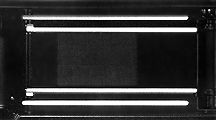 |
The curtains travel vertically across the film gate in about 6.5 milliseconds (The first AE Nikon, aperture priority EL, 1972 travelled at 7 milliseconds). At speeds slower than 1/125 second, the rear curtain starts moving after the front curtain is fully opened. Hence, the electronic flash synchronizes at shutter speeds of 1/125 second or slower. |
The AF Nikon F4 and current F5 also use modern hi-tech designed vertically travelled shutter curtain, thus raising the sync speed to 1/250 sec for the Nikon F4 and 1/300 sec for the F5 respectively. All Nikkormats and later mid-range Nikons (FM, FE. FM2, EM, FG series, FE II, FA, F301 and AF bodies) use vertical travelled shutter. Early un-official sources quoting Nikon has their top notch professional models to have a rugged shutter that can withstand minimum 150,000 exposure cycles and lower mid-range models with a minimum 50,000 exposure cycles.(4,000 + rolls and 1,400 rolls of 36 exposures in numbers respectively). That explains why many people favour Nikon cameras and it was regarded as one of the top cameras in terms of durability and ruggedness.
9. Self-Timer
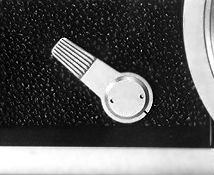 |
The self-timer is positioned in front, at the lower left side of the body, and can be set by turning the lever some 50° counterclockwise until it stops. It permits a delayed exposure of about 8 seconds, at any shutter speed from 1 to 1/1000 second. The self-timer can be set before or after winding the film, since it is independent of the shutter mechanism. |
Since the mechanism of the self timer is mechanical, if left unused for long time, it may need some periodical 'exercise'. It is a good habit for users' self maintainance.
All Nikkormats except the FT, FS and this FTn have accessory hot shoe mount. Instead, the Nikkormat has two flash terminals locate at the side of the body, marked M (in red) and X (in black), on the right side of the camera body. The M-terminal is used with M, FP and MF class flahsbulbs.
 |
The M- and FP-class bulbs synchronize with the camera at all shutter speeds from B to 1/1000 second, and the MF-class bulbs at speeds up to 1/60 second. The X-terminal is designed for electronic flash units with standard PC synch cord. The electronic flash synchronizes with the camera at 1/125 second, or slower. |
An accessory shoe must be used when attaching the Nikon BC-7 flash unit, clip-on type flash units or other accessories onto the Nikkormat camera. The base of the accessory shoe is fixed between the viewfinder housing and the finder eyepiece.
Nikon
orig9inal Sppedlight from SB-1 to SB-20 can be accessed by CLIKING HERE
11. Reflex Mirror//Mirror Lock Up
The instant return reflex mirror of the Nikkormat FTN can be lifted and locked up,
out of the optical path, by means of the mirror locking knob located on the upper
right side of the camera scutcheon. The mirror lifts as the locking knob is slid
downward, and it remains locked up until the knob is pushed upward, when it returns
to its original viewing position.
The mirror can be locked up independently before or after the shutter release or
film winding (The lever just above the lens release button, press downward to flip
the mirror up). The mirror lock-up is necessary when using some fisheye lenses or
scientific lenses like the 10mm OP Nikkor, or for other applications requiring
an absolute vibration-free condition, such as extreme high magnification works, telephoto/astro
photography etc.
12. Depth-of- Field Preview Button
The depth-of-field preview button is conveniently located near the shutter release button on top of the camera body. But may not be to comfotable for strechting your index finger to perform two tasks.
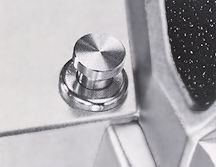 |
Since then, the EL was given a more comfotable dual fingers operations by moving the DOF lever to the front section As with the Nikon F, this was eventually made standard in all Nikons after the Nikkormats F series. When the button is pressed, the lens diaphragm stops down to the preselected aperture, permitting the photographer to check the depth of field and to make any adjustments in the exposure setting, if necessary. |
The depth-of-field preview button is also used for stop-down exposure measurement when using a lens without a meter coupling prong.
13. Lens-Lock Release Button
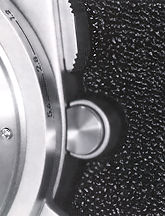 |
The lens lock-release button is located on the right side, to the front of the camera body. It facilitates the interchange of the bayonet-type Nikkor lenses which can be easily removed from the body by pressing the lens-lock release button and turning the lens clockwise as far as it will go. |
14. Lens Mount Flange
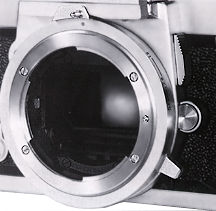 |
The original Nikon F mount. The broad, specially-treated lens mount flange (44mm in diameter) ensures secure seating, correct alignment for all the Nikkor interchangeable lenses. Since major input of data (Shutter speeds, ASA, aperture values & focusing on the lens) are centered around the lens mount, the mount was brass made to maintain highest degree of ruggedness |
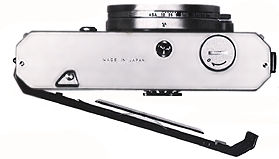 |
The hinged-type camera back of the N ikkormat camera pops open as the release catch is pulled down, making possible speedy and easy loading or unloading of film. When the camera back is opened, the film frame counter resets itself automatically to "S", two frames before "0". |
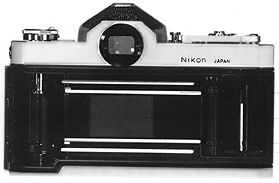 |
16. Tripod Socket |
| Back | Part I & II covers : Viewfinder & Focusing Screen | Film Advance Lever | Frame Counter | Film Rewind Crank | Film Plane Indicator | Shutter Speed Ring | Shutter Release Button
| Back to Nikkormat FTn
Index Page |
| Back |
to Main Index
Page of Nikkormats
| Message Board | for your favourite Nikkormats
| Message Board |
for your Nikon Optics in a shared environment
| Message Board |
Specifically for Dispose or Looking for Nikon/Nikkor Photographic
Equipment
History
& Background
of Nikkormat Cameras
| "Nikomat" Picture Library
of Japanese local version | Outline
the
major
key features and differences
of various models
The
Camera Bodies
| FT | FS | FTn | EL | FT2 | ELW | FT3 | EL2
This
site is made out 15.5MB with 478 items
(Jpeg, Gif, PDF & HTML files) (Last Update: 25th May 1999)
| Main Reference
Map
|
HTML Format: FT | FS | FTn | EL | FT2 | ELW | FT3 | EL2 | AW-1 Motor Winder
PDF Format: FT
| FS | FTn | EL | FT2 | ELW | FT3 | EL2 | AW-1 Motor Winder
| Specifications |
FT
| FS | FTn | EL | FT2 | ELW | FT3 | EL2
 |
The Eyes of Nikon:- |
Fisheye-Nikkor Lenses - Circular | Full Frame | Ultrawides Lenses - 13mm15mm18mm20mm | Wideangle Lenses - 24mm28mm35mm |
Standard Lenses - 45mm 50mm 58mm | Telephoto Lenses - 85mm105mm135mm180mm & 200mm |
Super-Telephoto Lenses - 300mm 400mm 500mm 600mm 800mm 1200mm |
Special Application lenses:
Micro-Nikkor Lenses - 50mm~55mm -60mm 85mm -105mm 200mm Micro-Zoom 70-180mm
Perspective Control (PC) - 28mm 35mm PC-Micro 85mm
Dedicated Lenses for Nikon F3AF: AF 80mm f/2.8 | AF 200mm f/3.5 EDIF
Depth of Field Control (DC): 105mm 135mm
Medical Nikkor: 120mm 200mm
Reflex-Nikkor Lenses - 500mm 1000mm 2000mm
Others: Noct Nikkor | OP-Nikkor | UV Nikkor 55mm 105mm | Focusing Units | Bellows-Nikkor 105mm 135mm
Nikon Series E Lenses: 28mm35mm50mm100mm135mm | E-Series Zoom lenses: 36~72mm75~150mm70~210mm
MF Zoom-Nikkor Lenses: 25~50mm | 28~45mm | 28~50mm | 28~85mm | 35~70mm | 36~72mm E | 35~85mm | 35~105mm | 35~135mm |
35~200mm | 43~86mm | 50~135mm | 50~300mm | 70~210mm E | 75~150mm E | 80~200mm | 85~250mm |
100~300mm | 180~600mm | 200~400mm | 200~600mm | 360~1200mm | 1200~1700mm
Tele-Converters: TC-1 | TC-2 | TC-200 | TC-201 | TC-300 | TC-301 | TC-14 | TC-14A | TC-14B | TC-14C | TC-14E | TC-16 | TC-16A | TC-20E
![]()
Nikon F
| Nikon F2 |
Nikon
F3
| Nikon F4 |
Nikon
F5
| Nikon F6 |
Nikkormat / Nikomat |
Nikon FM
| Nikon FE/ FA | Nikon EM/FG/FG20 | Nikon Digital SLRs | Nikon - Other models
MIR Supports for Photographic Community: Various Message Boards/Community
Forums
Nikon
F-series|
Nikon
F2-series|
Nikon
F3-series|
Nikon F4-series| Nikon
F5-series|Nikkormat/Nikomat-series
Nikon FM-series|Nikon
FE-series|Nikon
FA|Nikon
Digital
SLR
series|Various
Nikon
Models|Nikkor
Optic
-shared
Others:- Free Trade Zone - Photography| Free Trade Zone - Business Community |Free To Zouk - Photographic Community
Apple's Mac Public Community Message Board | Windows based PC &
Apple/Mac
Public Community Trade Exchange Centre
Recommended links to understand
more technical details related to the Nikkor F-mount and production Serial Number:
http://rick_oleson.tripod.com/index-153.html by: my friend, Rick Oleson
http://www.zi.ku.dk/personal/lhhansen/photo/fmount.htm by: Hansen, Lars Holst
http://www.mir.com.my/rb/photography/hardwares/nikonfmount/lens2.htm
http://www.photosynthesis.co.nz/nikon/serialno.html
About
this photographic
site.
Home - Photography
In Malaysia
![]()
Copyright
© 1998.
HIURA Shinsaku ® ; Nikomat ML, Japan,
in collaboration with leofoo ®. MIR Web Development Team.
* Credit: A
Great thanks to Mr Denis Pleic for his volunteering
effort to reedit content and and patching some grammatical mistakes found in this
section of the PIM site. Miss
Rissa (Marketing) & Edward
(Techical) of Shriro Malaysia, distributor of Nikon cameras in Malaysia, in providing
so many useful inputs to make this site possible. Mr Hong,
Ipoh for lending me his FT2 to take some of the images used in this site. This site
is created for his eldest son, Yuen who has picked up his father's hobby and
the FT-2. My friend, John Walls from Florida, US for his images of the FTn
body and the Zoom Nikkor
43-86mm.
[Left Brain][Right brain][Home-MIR] [Invention][Art & Design][Clubs]
[Portfolios][On assignments] [Trading room][Knowledge & Resources] [Free-trade-zone][Thoughts & opinions][Links]